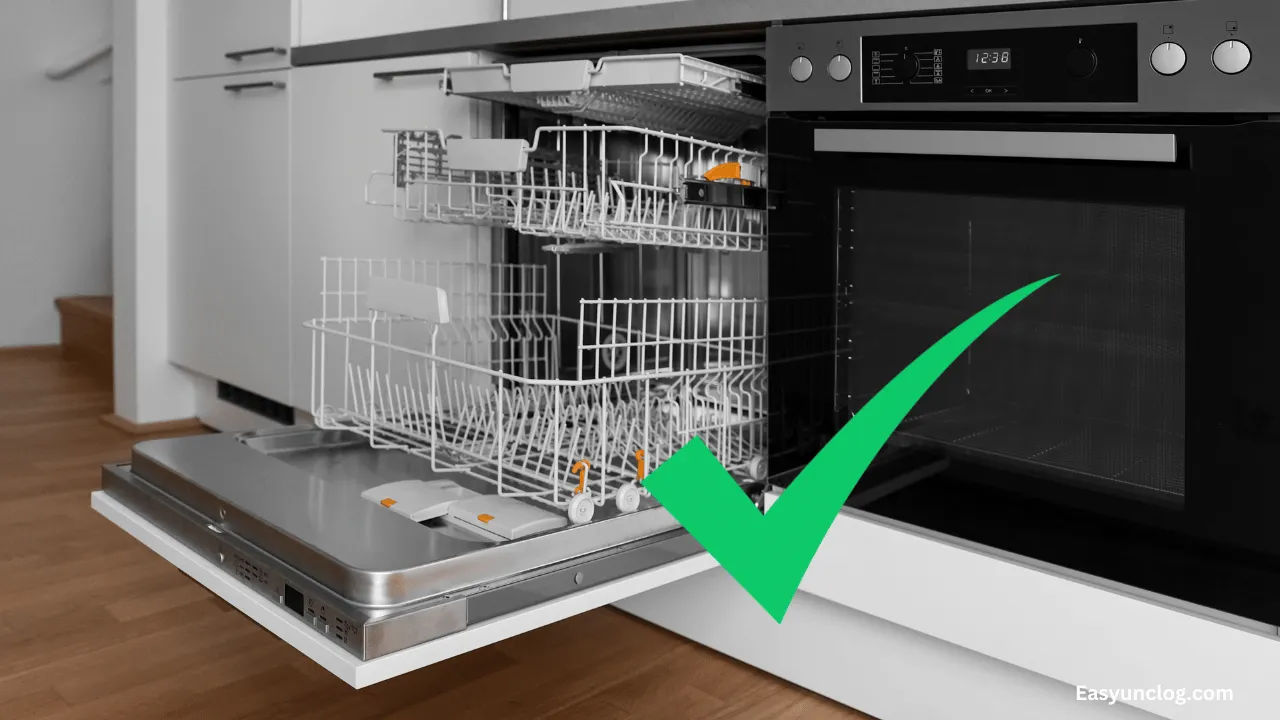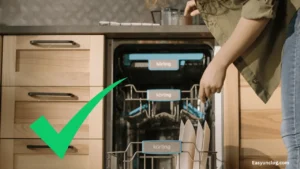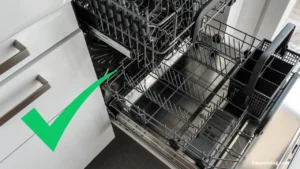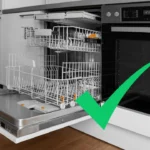Dishwashers are a staple of convenience in modern kitchens, saving time and ensuring clean, hygienic dishwashing. However, like any appliance that uses water, dishwashers are prone to calcium buildup due to hard water—a condition where water contains high levels of minerals like calcium and magnesium.
This buildup can clog the dishwasher’s spray arms, filter, and drain, impairing its performance or even leading to malfunctions. Fortunately, unclogging a dishwasher with calcium buildup is a task you can often undertake yourself. This guide will walk you through the process step by step.
Contents
- 1 Understanding Calcium Buildup
- 2 Preventive Measures
- 3 Step-by-Step Guide to Unclogging a Dishwasher
- 4 Regular Maintenance Tips
- 5 When to Call a Professional
- 6 Conclusion:
- 7 FAQs
- 7.1 1. How often should I clean my dishwasher to prevent calcium buildup?
- 7.2 2. Can I use something other than vinegar to remove calcium buildup?
- 7.3 3. Will a water softener prevent calcium buildup in my dishwasher?
- 7.4 4. What should I do if my dishwasher isn’t cleaning well after removing calcium buildup?
- 7.5 5. Is calcium buildup harmful to my dishes or health?
- 7.6 6. Can I prevent calcium buildup by changing my detergent?
Understanding Calcium Buildup
Calcium buildup, or limescale as it’s commonly known, occurs when hard water evaporates and leaves behind calcium and magnesium deposits. These deposits can accumulate in your dishwasher’s internal components, leading to blockages that impair water flow and affect cleaning efficiency.
Recognizing the Signs of Calcium Buildup
The most apparent signs of calcium buildup in your dishwasher include:
- White, chalky residue on dishes and the interior of the dishwasher
- Decreased water pressure in the spray arms, leading to poorly cleaned dishes
- Slow or clogged drains
- An increase in the need to rewash dishes
Preventive Measures
Before diving into the unclogging process, it’s worth noting that prevention is the best strategy. Regular maintenance can significantly reduce the risk of calcium buildup. Here are a few preventive measures:
- Use a Water Softener: Installing a whole-house water softener is the most effective way to prevent calcium buildup. It removes hardness from the water before it enters your appliances.
- Regular Maintenance: Clean your dishwasher’s filter, spray arms, and drain to prevent buildup.
- Vinegar Rinse: Periodically run an empty dishwasher cycle with a cup of white vinegar on the top rack. Vinegar is a natural descaler that can help prevent calcium deposits.
Step-by-Step Guide to Unclogging a Dishwasher
Step 1: Prepare Your Dishwasher
- Safety First: Begin by unplugging your dishwasher or turning off its power at the circuit breaker to ensure your safety.
- Empty the Dishwasher: Remove all dishes and racks from your dishwasher to access all areas easily.
Step 2: Clean the Filter
- Locate the Filter: The filter is usually found at the bottom of the dishwasher.
- Remove and Clean: Twist to unlock and lift out the filter. Rinse it under hot running water and scrub gently with a soft brush to remove debris or calcium deposits.
- Reinstall the Filter: Once clean, reinstall the filter by reversing the removal process.
Step 3: Unclog and Clean the Spray Arms
- Remove the Spray Arms: Depending on your dishwasher model, the spray arms may snap off or require unscrewing.
- Clean the Holes: Use a piece of wire, a toothpick, or a small needle to clear the holes in the spray arms. Rinse them thoroughly under water.
- Soak in Vinegar: For severe buildup, soak the spray arms in white vinegar for a few hours before cleaning the holes.
- Reattach the Spray Arms: Reattach the spray arms to their original position once cleaned.
Step 4: Clear the Drain
- Access the Drain: Remove the cover to the dishwasher drain. This may require unscrewing, but many models allow easy, tool-free access.
- Remove Debris: Use a sponge or a soft cloth to clean around the drain. If debris is lodged, gently use pliers or tweezers to remove it.
- Flush with Vinegar and Baking Soda: Pour a mixture of baking soda and vinegar down the drain to fizz away stubborn deposits. After 15 minutes, pour boiling water down the drain to flush out the mixture and any loosened deposits.
Step 5: Run a Cleaning Cycle
- With Vinegar: Place a large bowl filled with white vinegar on the top rack and run the dishwasher on its hottest cycle. Vinegar is an effective natural descaler and will help remove any remaining calcium buildup.
- With a Commercial Dishwasher Cleaner: Consider using a commercial dishwasher cleaner designed to remove limescale for severe buildup. Follow the product instructions for the best results.
Regular Maintenance Tips
To keep your dishwasher running smoothly and prevent future clogs, consider these maintenance tips:
- Regular Cleaning: Clean the filter, spray arms, and drain regularly to prevent buildup.
- Use Rinse Aid: Rinse aid can help prevent spotting and buildup on dishes and the dishwasher’s interior.
- Check for Leaks: Regularly inspect hoses and connections for leaks, as these can lead to water damage and affect your dishwasher’s performance.
Calcium buildup in dishwashers is a common issue that can lead to inefficiency and malfunctions if not addressed. However, with the right approach and regular maintenance, you can unclog your dishwasher and prevent future buildup, ensuring that your appliance continues to operate efficiently.
After completing the cleaning cycle, assess your dishwasher’s performance by running a load of dishes as usual. Look for improvements in water flow, drainage, and overall cleanliness of the dishes.
If problems persist, deeper issues might be at play, such as malfunctions with the dishwasher’s pump or internal hoses, which might require professional attention.
When to Call a Professional
While many instances of calcium buildup can be resolved with the steps outlined above, some situations may require professional assistance. Here are signs that it’s time to call in a technician:
- Persistent Poor Performance: If your dishwasher continues to perform poorly after thorough cleaning, there may be a mechanical issue.
- Visible Damage: If you notice damage to the spray arms, filter, or other components, these parts may need repair or replacement.
- Water Not Draining: If water remains in the dishwasher after you’ve cleaned the drain, there could be a clog further down the line or an issue with the dishwasher’s pump.
Conclusion:
Unclogging a dishwasher with calcium buildup is a task well within the reach of most homeowners. Following the steps outlined in this guide, you can restore your dishwasher’s performance and extend its lifespan.
Regular maintenance and preventive measures, such as using a water softener and running vinegar rinses, can prevent calcium buildup and ensure your dishwasher runs smoothly for years to come.
Remember, the key to a well-functioning dishwasher is addressing issues as they arise and preventing them through regular care and maintenance.
By monitoring the signs of calcium buildup and acting promptly to address them, you can avoid the inconvenience of clogs and enjoy the benefits of an efficient, hardworking dishwasher in your home.
FAQs
1. How often should I clean my dishwasher to prevent calcium buildup?
To prevent calcium buildup, it’s recommended to clean your dishwasher’s filter, spray arms, and drain once a month. Additionally, running a vinegar rinse every few months can help prevent the accumulation of calcium deposits.
2. Can I use something other than vinegar to remove calcium buildup?
You can also use a commercial dishwasher cleaner or descaler specifically designed to remove calcium buildup. For a natural alternative, citric acid is also effective; you can run a cycle with a few tablespoons of citric acid powder placed in the detergent compartment.
3. Will a water softener prevent calcium buildup in my dishwasher?
Absolutely. A water softener removes minerals before entering your dishwasher, significantly reducing the likelihood of calcium and limescale buildup. It’s one of the most effective preventive measures.
4. What should I do if my dishwasher isn’t cleaning well after removing calcium buildup?
If performance issues persist after cleaning, check for other problems, such as a malfunctioning heating element, clogged or damaged hoses, or a faulty pump. It might be necessary to consult a professional repair service.
5. Is calcium buildup harmful to my dishes or health?
Calcium buildup is not harmful to health; it’s simply mineral deposits left from hard water. However, it can impair your dishwasher’s performance, leading to poorly cleaned dishes that may have residue.
6. Can I prevent calcium buildup by changing my detergent?
While changing your detergent won’t prevent calcium buildup caused by hard water, using a detergent with a built-in water softener component can help reduce the effects of hard water on your dishes.








